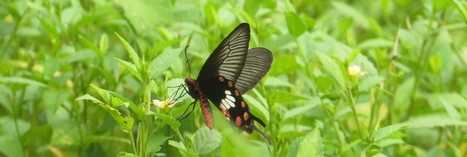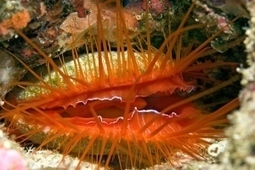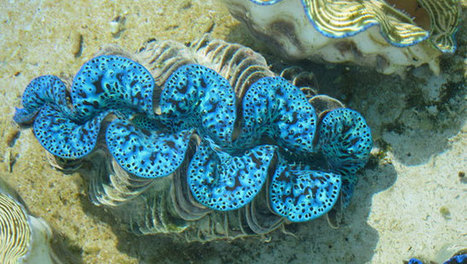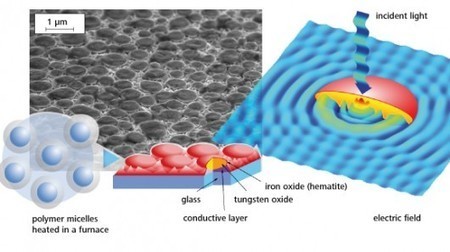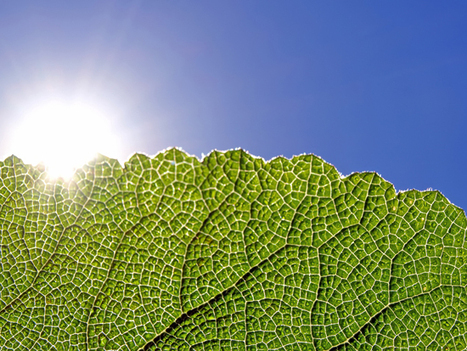 Your new post is loading...
 Your new post is loading...
Researchers recently took cues from butterflies to design thin film solar cells that can better absorb light. The rose butterfly, common to India, has soft black wings that keep the insect warm with the sun’s heat. Mimicking the design of the butterfly’s wings, the scientists created a solar cell that The Verge reports can gather light twice as efficiently.
From the wonderful world of biomimicry comes a solar energy breakthrough based on the posture at rest of a small butterfly called the Cabbage White. Who knew that voguing is still a thing? Apparently, this stylin’ butterfly forms a uniquely angled “V” with its wings, which according to new research from the UK’s University of Exeter indicates a new pathway for developing lighter, more efficient solar energy harvesting systems.
"Inspired by the way iridescent bird feathers play with light, scientists have created thin films of material in a wide range of pure colors — from red to green — with hues determined by physical structure rather than pigments. Structural color arises from the interaction of light with materials that have patterns on a minute scale, which bend and reflect light to amplify some wavelengths and dampen others. Melanosomes, tiny packets of melanin found in the feathers, skin and fur of many animals, can produce structural color when packed into solid layers, as they are in the feathers of some birds. “We synthesized and assembled nanoparticles of a synthetic version of melanin to mimic the natural structures found in bird feathers,” said Nathan Gianneschi, a professor of chemistry and biochemistry at the University of California, San Diego. “We want to understand how nature uses materials like this, then to develop function that goes beyond what is possible in nature."
"The rare blue morpho butterfly is among the largest butterflies in the world and one of the most spectacular with its brown wings that suddenly turn iridescent blue. This amazing display happens when blue light reflects off the layers of microscopic scales on its wings. 3M scientists studied the butterfly to mimic this effect in a window film."
"Nano-imprint technology, a technique in which microscopic indentations are made on an object's surface, is changing the nature of various products, including TV screens, semiconductors and tissue cultures. One application already being used is in making so-called moth-eye film, a transparent film developed by Dai Nippon Printing that reflects almost no light. This film is modeled after a moth's eyes, which are known for reflecting little to no light, allowing the insect to better hide from predators. This is achieved by minute bumps that are around 200 nanometers, 200 billionths of a meter, in diameter. Nano-imprint technology helped researchers create such surfaces on film."
"Shrimps' eyes have been revealed as the latest weapon against cancer, with their unique vision set to be adapted to diagnostic cameras. University of Queensland research has found the shrimps' compound eyes were able to detect polarised light, which could be mimicked to detect cancer cells."
Industry and consumer awareness of biomimetics is on the rise as demand for naturals continues to climb, with the combination of science and nature increasingly appealing for skin care products.
"As molluscs go, Ctenoides ales is quite literally one of the flashiest. A native of the Indo-Pacific region, the creature is known as the disco clam because the soft tissues of its ‘lips’ flash like a mirror ball above a dance floor. A study published today finds that the disco clam achieves this using nanoparticles of silica to reflect light.".
"Check out these [nature-inspired] developments in solar energy and LED lighting. So many possibilities yet to be discovered."
"Turkey skin [...], can shift from red to blue to white, thanks to bundles of collagen that are interspersed with a dense array of blood vessels. [...] Seung-Wuk Lee, UC Berkeley associate professor of bioengineering, led a research team in mimicking this color-changing ability to create biosensors that can detect volatile chemicals."
"Nature’s inventiveness often inspires human innovation as in the well-known case of hook-and-loop fasteners: Swiss engineer George de Mestrel turned a hiking annoyance (burrs) into a handy tool (Velcro). But did you know that safety road markers were inspired by a cat’s eyes reflecting headlights. [...] “Eyeshine” may be most familiar as a feline phenomenon, but it occurs in a tremendous variety of animals, from moths to whales. It’s caused by the tapetum lucidum, a reflective layer behind the photosensitive part of the eye which bounces photons back, giving them a second chance to be seen. This ability is a major advantage at night and in the deep sea and has evolved many times in many different forms."
"Researchers at the University of Pittsburgh (Pitt), US, achieved a breakthrough in mimicking biological responses in non-living organisms. The study is the first to show that polymeric gels, such as hydrogels, can be moulded and reconfigured through the application of light, a process that, for example, could revolutionise microfluidic devices by making a single system adaptable to a variety of functions — potentially a huge cost savings."
"A Canadian company is fighting counterfeiters by employing one of the most sophisticated structures in nature: a butterfly wing. To be precise, Nanotech Security Corp. in Vancouver is using the natural structure of the wings of a Morpho butterfly, a South American insect famous for its bright, iridescent blue or green wings, to create a visual image that would be practically impossible to counterfeit. The technology was developed at British Columbia’s Simon Fraser University, and licensed to the company."
|
"Extending the limit of the classical microscope's resolution has been the holy grail of microscopy for over a century. Physical laws of light make it impossible to view objects smaller than 200nm – the smallest size of bacteria – using a normal microscope alone. However, superlenses that enable us to see beyond the current magnification have been the goal since the turn of the millennium.
After a team at Bangor University's School of Electronic Engineering used a nanobead-derived superlens to break the perceived resolution barrier, the same team has achieved another world first. The team, led by Dr Zengbo Wang, and in colloboration with Professor Fritz Vollrath's silk group at Oxford University's Department of Zoology, has used a naturally occurring material – dragline silk of the golden web spider – as an additional superlens, applied to the surface of the material to be viewed, that provides an additional 2-3 times magnification. This is the first time that a naturally occurring biological material has been used as a superlens."
The atomic structure of a moth’s eye and lotus leaves have inspired scientists to create a new glass coating that could increase the efficiency of solar panels by up to six per cent. “While lotus leaves repel water and self-clean when it rains, a moth’s eyes are antireflective because of naturally covered tapered nanostructures where the refractive index gradually increases as light travels to the moth’s cornea,” said Tolga Aytug, member of ORNL’s Materials Chemistry Group. “Combined, these features provide truly game-changing ability to design coatings for specific properties and performance.”"
"Most of us were born and will die a certain color, but octopuses are masters of their hue, changing from transparent to shades of red, pink, purple and blue by stretching and relaxing their skin. If we could unlock their secret and wrap our buildings in octopus skin, then city skylines might shimmer a spectrum of colors and opacities as the sun waxed and waned."
"Researchers at the University of California at Berkeley announced today that they have developed an ultra-thin material that can change color on demand by bouncing back light on the nanoscale level. Well, the on-demand element is a little more nuanced. The “chameleon skin” material actually changes color when flexed, or when a small amount of force is applied to the surface."
"Brilliant shades of blue and aqua coat the iridescent lips of giant clams, but these shiny cells aren't just for show, new research finds. The iridescent sheen directs beams of sunlight into the interior of the clam, providing light for algae housed inside. [...] The giant clams' colorful and sparkly sheen may one day inspire new forms of clean technology, the researchers said. For instance, traditional solar cells work well in direct sunlight, but not when they get too hot. With the clam's design, a reflective sheen could help solar cells stay cool even when they're exposed to intense sunlight,.."
"Based on the camouflage abilities of octopuses and cuttlefish, engineers in the US have built a flexible material that changes colour to match its surroundings. The new design features a grid of 1mm cells, containing a temperature-driven dye that switches colour on demand." "
"As nocturnal creatures, moths need to maximize how well they can see in the dark whilst remaining less visible to avoid predators. This ability to collect as much of the available light as possible and at the same time reflect as little as possible, has inspired Researchers at the Swiss Federal Laboratories for Materials Science and Technology (Empa) to design a new type of photoelectrochemical cell using relatively low cost materials."
By mimicking the design of a firefly's light-emitting organ, researchers built an LED that shines 55 percent brighter.
Here's how two U.S. firms pursued the holy grail of bioinspired design: artificial photosynthesis.
"The Mirasol display technology (developed by Qualcomm) is based on biomimetics - that is, technology that imitates nature. The natural phenomenon that makes a butterfly’s wings or a peacock’s feathers shimmer and give off their rich, striking colors is the same exact quality that drives how Mirasol displays generate color. How do butterflies and peacocks do it? Through microscopic structures on their wings and feathers they are each able to create truly vivid colors simply by causing light to interfere with itself. This "interference" is the reason the term "interferometric" comes into play."
"Butterfly wings can do remarkable things with light, and humans are still trying to learn from them. Physicists have now uncovered how subtle differences in the tiny crystals of butterfly wings create stunningly varied patterns of color even among closely related species. The discovery, reported today in the Optical Society's (OSA) open-access journal Optical Materials Express, could lead to new coatings for manufactured materials that could change color by design, if researchers can figure out how to replicate the wings' light-manipulating properties."
"We used the biological influences of this specific place in Hawaii as the guiding principles for the architecture, building systems and overall experience. Hydronic passive cooling and ventilation supported by a seawater well, natural daylighting and the absence of mechanical fans all support a high-performance design based on the ecology of the Pacific."
|
 Your new post is loading...
Your new post is loading...
 Your new post is loading...
Your new post is loading...




